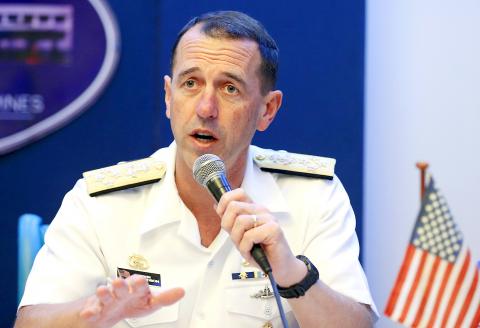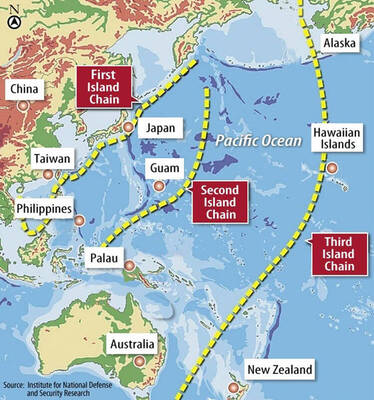The US Navy has not ruled out sending an aircraft carrier through the Taiwan Strait, despite military technology advances by China that pose a greater threat to US warships than ever before, the chief of US naval operations said yesterday.
Washington sent ships through the strategic waterway three times last year as it makes more frequent transits of the strait that separates Taiwan from China, but it has not dispatched a carrier in more than 10 years.
During that time, China has modernized its forces with missiles designed to strike enemy ships.

Photo: AP
“We don’t really see any kind of limitation on whatever type of ship could pass through those waters,” Admiral John Richardson told reporters in Tokyo when asked if more advanced Chinese weapons posed too big a risk.
“We see the Taiwan Strait as another [stretch of] international waters, so that’s why we do the transits,” he said.
Aircraft carriers, typically equipped with about 80 aircraft and crewed by about 5,000 sailors, are key to the US military’s ability to project power globally.
On Tuesday, a US official told reporters that the US was closely watching Chinese intentions toward Taiwan as advances in military technology give Beijing’s forces greater capability to occupy the nation.
In a report, the US Defense Intelligence Agency called Taiwan the “primary driver” for China’s military modernization.
Richardson, who visited China before traveling to Japan, said that he told his Chinese counterparts that Washington was opposed to any unilateral action by Beijing or Taipei.
He also urged China to stick to international rules during unplanned naval encounters at sea.
That request came after a Chinese destroyer approached the USS Decatur in October last year and forced it to change course as it challenged Chinese territorial claims in the contested South China Sea with a freedom of navigation operation.
“We have made this very clear that this was an excursion, a departure from the normal adherence to those rules and we would hope that behavior in the future would be much more consistent,” Richardson said. “We should not see each other as a threatening presence in these waters.”
The US Navy continues to pass through waters in the South China Sea that Beijing considers its territory.
On Monday last week, a US guided-missile destroyer sailed within 12 nautical miles (22.2km) of a Chinese-occupied island, prompting Beijing’s rebuke that it had “gravely infringed upon China’s sovereignty.”
China, which claims almost all of the strategic waterway, has said that its intentions are peaceful. Taiwan, Brunei, Indonesia, Malaysia, the Philippines and Vietnam have competing claims.
The Ministry of National Defense yesterday thanked allied nations’ military commanders for their support in maintaining peace and stability in the Taiwan Strait.
The Taiwan Strait is an international sea zone, the ministry said, adding that it would respect the US’ decision should it conduct naval or other military activities in the waterway.
Following the circumnavigation of Taiwan by Chinese People’s Liberation Army (PLA) Air Force aircraft, the PLA Navy has also begun routine patrols west of the median line of the Taiwan Strait, the ministry said, adding that while such actions have increased pressure on Taiwan regarding combat readiness, the nation’s armed forces are capable of reacting to various scenarios.
Additional reporting by Lo Tien-pin

The US government has signed defense cooperation agreements with Japan and the Philippines to boost the deterrence capabilities of countries in the first island chain, a report by the National Security Bureau (NSB) showed. The main countries on the first island chain include the two nations and Taiwan. The bureau is to present the report at a meeting of the legislature’s Foreign Affairs and National Defense Committee tomorrow. The US military has deployed Typhon missile systems to Japan’s Yamaguchi Prefecture and Zambales province in the Philippines during their joint military exercises. It has also installed NMESIS anti-ship systems in Japan’s Okinawa

TRAGEDY STRIKES TAIPEI: The suspect died after falling off a building after he threw smoke grenades into Taipei Main Station and went on a killing spree in Zhongshan A 27-year-old suspect allegedly threw smoke grenades in Taipei Main Station and then proceeded to Zhongshan MRT Station in a random killing spree that resulted in the death of the suspect and two other civilians, and seven injured, including one in critical condition, as of press time last night. The suspect, identified as a man surnamed Chang Wen (張文), allegedly began the attack at Taipei Main Station, the Taipei Fire Department said, adding that it received a report at 5:24pm that smoke grenades had been thrown in the station. One man in his 50s was rushed to hospital after a cardiac arrest

‘WIN-WIN’: The Philippines, and central and eastern European countries are important potential drone cooperation partners, Minister of Foreign Affairs Lin Chia-lung said Minister of Foreign Affairs Lin Chia-lung (林佳龍) in an interview published yesterday confirmed that there are joint ventures between Taiwan and Poland in the drone industry. Lin made the remark in an exclusive interview with the Chinese-language Liberty Times (the Taipei Times’ sister paper). The government-backed Taiwan Excellence Drone International Business Opportunities Alliance and the Polish Chamber of Unmanned Systems on Wednesday last week signed a memorandum of understanding in Poland to develop a “non-China” supply chain for drones and work together on key technologies. Asked if Taiwan prioritized Poland among central and eastern European countries in drone collaboration, Lin

ON ALERT: Taiwan’s partners would issue warnings if China attempted to use Interpol to target Taiwanese, and the global body has mechanisms to prevent it, an official said China has stationed two to four people specializing in Taiwan affairs at its embassies in several democratic countries to monitor and harass Taiwanese, actions that the host nations would not tolerate, National Security Bureau (NSB) Director-General Tsai Ming-yen (蔡明彥) said yesterday. Tsai made the comments at a meeting of the legislature’s Foreign Affairs and National Defense Committee, which asked him and Minister of National Defense Wellington Koo (顧立雄) to report on potential conflicts in the Taiwan Strait and military preparedness. Democratic Progressive Party (DPP) Legislator Michelle Lin (林楚茵) expressed concern that Beijing has posted personnel from China’s Taiwan Affairs Office to its